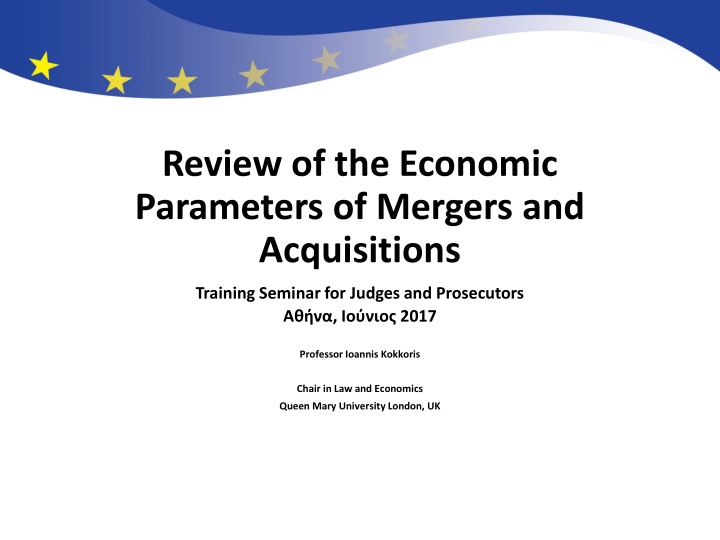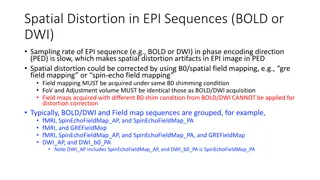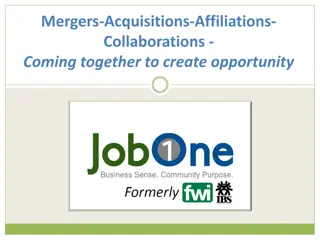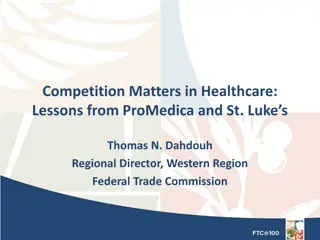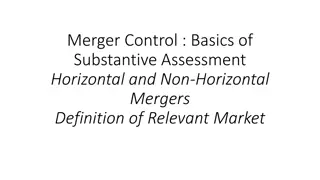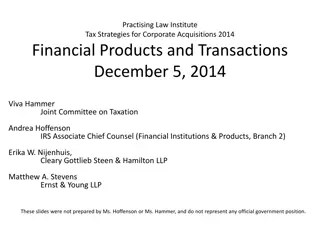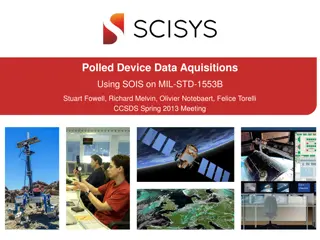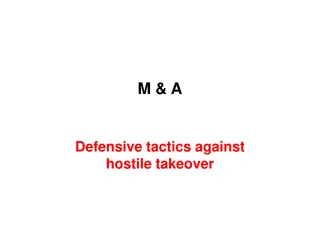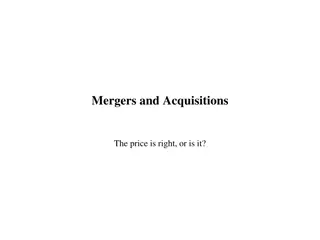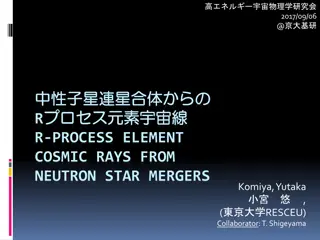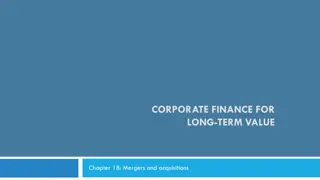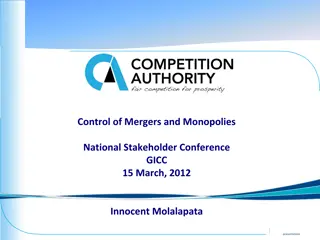Economic Parameters of Mergers and Acquisitions Analysis
This review delves into various quantitative methods and analysis techniques used to assess the economic impact of mergers and acquisitions, including price correlation, price elasticity, price/concentration analysis, natural experiments/shock analysis, and critical loss analysis. Case studies such as Price Elasticity with INEOS/Kerling and Price Correlation with Pan Fish/Marine Harvest/Fjord Seafood are also examined.
Download Presentation

Please find below an Image/Link to download the presentation.
The content on the website is provided AS IS for your information and personal use only. It may not be sold, licensed, or shared on other websites without obtaining consent from the author.If you encounter any issues during the download, it is possible that the publisher has removed the file from their server.
You are allowed to download the files provided on this website for personal or commercial use, subject to the condition that they are used lawfully. All files are the property of their respective owners.
The content on the website is provided AS IS for your information and personal use only. It may not be sold, licensed, or shared on other websites without obtaining consent from the author.
E N D
Presentation Transcript
Review of the Economic Parameters of Mergers and Acquisitions Training Seminar for Judges and Prosecutors , 2017 Professor Ioannis Kokkoris Chair in Law and Economics Queen Mary University London, UK
Market Definition H : , , . H : H , .
Quantitative Methods Price correlation analysis (market definition-assessment of merger s effects). Examines the extent to which the prices of two products move together over time. If the price of one good constrains the price of the other, the two price series follow a similar pattern. (BP/E.ON (Aral), Nestl /Perrier) Price elasticity analysis (market definition-assessment of merger s effects). This type of analysis uses econometrics to assess the responsiveness of the demand for a product or group of products to a change in price. The more elastic the demand, the less likely is it that a price rise would be profitable. (Guinness/GrandMet) Price/concentration analysis (assessment of merger s effects). Explores the degree to which higher levels of concentration coincide with higher prices and margins in order to give an insight into the likely competitive impact of an increase in market concentration. Capital/M lnlycke/Kolmi, Reed Elsevier plc and Harcourt General, Inc) (Staples Inc., Nordic
Natural Experiments/Shock analysis (market definition-assessment of merger s effects). It involves the analysis of discrete events affecting competition in the market to obtain an insight into the competitive interaction between products or regions. (Kimberly Clark/Scott) Win/Loss Analysis/Bidding studies (assessment of merger s effects). Competition takes the form of bidding for contracts. The analysis of bid outcomes can identify the degree of closeness of competition between the bidding firms. (Oracle/Peoplesoft, Waterhouse/Coopers & Lybrand) GE/Instrumentarium, Price Merger simulation (assessment of merger s effects). Merger simulation combines estimates of demand elasticities with an assumption about the nature of competition to simulate the competitive impact of a proposed merger. (Centrica/Dynegy, Oracle/Peoplesoft, GE/Instrumentarium) Volvo/Scania and
Critical loss analysis (CLA) (market definition-assessment of mergers effects). CLA makes the SSNIP market definition test operational by estimating how much the hypothetical monopolist s sales would have to fall in order to make the hypothesised price increase unprofitable. (Tenet Healthcare Corporation, Swedish Match North America Inc, Occidental Petroleum Corp, US v SunGard and Comdisco) Switching analysis (assessment of merger s effects). Uses econometric analysis, internal company documentary evidence or survey results to estimate the extent to which two products are particularly close competitors. (Carnival Corporation, Volvo/Renault)
Case Studies Price Elasticity: INEOS / Kerling Price Correlation: Pan Fish/Marine Harvest/Fjord Seafood
INEOS/Kerling Merger to monopoly in the UK or a wider European market? Merger between the only two UK producers of S- PVC (used for the manufacture of window frames and pipes) UK share around 70% (30% imports) Share of any wider geographic definition < 30% Agreement that the deal raised no issues if the market is wider than the UK
INEOS/Kerling Concern that prices to UK customers might increase: Could importers bring in sufficient additional materials? Were imports substitutes for domestic supplies, or are they inferior due to increased lead time/reliability issues? Are all customers equally capable of switching to imports? If not, is it possible to identify and price discriminate against customers who are less willing or able to switch?
Price Elasticity: Requirements for a robust model of demand are high Estimating demand elasticities directly answers the SSNIP: SSNIP asks how much demand would be lost if prices went up by 5%-10% Elasticity is just a measure of how sensitive demand is to price In practice, obtaining robust estimates can be very challenging: Finding an appropriate theoretical framework can be challenging Getting good enough data to test the demand model is also a problem
The demand for data: Key challenges in putting together detailed data responses No transactions data sets are ever entirely clean Returns End of period discounts Financial adjustments Correct economic treatment depends on the analysis Less problematic if an entire transactions database is requested (e.g. Pan Fish/Marine Harvest) allowing robustness checks of different treatments In INEOS/Kerling it did matter, as the Commission wanted the data to be aggregated by customer type The Commission therefore required 4 different cuts of all the data (with/without returns, with/without end-of-period discounts) significantly increasing the workload Transaction data are necessary to understand what story the data tell about competition in the market to be as prepared as possible for these potential technical issues
Customer analysis in the INEOS/Kerling Customer level analysis was carried out for all the parties large UK customers (accounting for over 95% of sales) Many customers multi-source from domestic suppliers and importers Many customers switched either wholly or in part between importers and the merging firms No evidence that there were any customers captive to UK supplies (customers of all sizes and from all industry groups source from importers and/or switch) Customers relying entirely on UK supplies did not pay more (i.e. no evidence of market power for the UK duopoly resulting in higher prices for UK only customers pre-merger) Commission verified by talking to customers Commission also benefitted from data provided by importers, showing a significant response to outages at UK production facilities (not visible from public data)
The INEOS/Kerling case Evidence of customers switching to importers wholly/partly Company A: volumes taken from merging firms over time 2,500 1,000 Volume Net Price Average EEA Price 900 2,000 800 700 Volume sales (units) 1,500 600 Average price ( ) 500 1,000 400 300 500 200 100 - - 1 2 3 4 5 6 7 8 9 10 11 12 1 2 3 4 5 6 7 8 9 10 11 12 1 2 3 4 5 6 7 8 9 10 11 12 1 2 3 4 5 6 7 8 9 10 11 12 1 2 3 4 5 6 7 8 9 10 11 12 2003 2004 2005 2006 2007
The INEOS/Kerling case 1100 No evidence of price discrimination against those not using importers 1050 Average price ( /tonne) 1000 950 900 850 800 0% 10% 20% 30% 40% 50% 60% 70% 80% 90% 100% Importer share
Pan Fish/Marine Harvest/Fjord Seafood Dominance in Scottish salmon or wider market for farmed salmon? Merger between the two largest salmon farming companies in the world: both with significant operations in Scotland and Norway The parties account for: around 30% of all Atlantic salmon farmed in Europe (global share is similar) around 45% of the Scottish salmon harvest Several theories of harm raised by the UK Competition Commission and DGCCRF in France: Short term unilateral output restriction (e.g. harvest early) Long term unilateral output restriction (e.g. buy fewer eggs) Post merger price discrimination UK cleared unconditionally: France required divestments in Scotland (although less than had been offered in Phase I)
Pricing Correlation analysis Even strong results from pricing analysis may not be enough Strong price correlation results suggested wider markets: Pan Fish/MH/FS: between Scottish and Norwegian salmon However, pricing analysis doesn t directly answer the SSNIP test Increasingly the authorities will look for evidence of shocks that would drive prices apart absent competition INEOS/Kerling Increase in East European consumption relative to the UK Exchange rate shock ( / ) Pan Fish/MH/FS: Increased Russian demand for Norwegian salmon Large (25%) reduction in Scottish production due to high costs In the end, the pricing evidence was influential in both cases: but not until modelling approaches had been exhausted
Pricing analysis: Norwegian and Scottish salmon prices correlated and stationary 5 4 Euro par kg 3 2 1 0 Jan-03 Jul-03 Jan-04 Jul-04 Jan-05 Jul-05 Jan-06 Jul-06 Ecossais Norvegien
Pricing analysis: S-PVC prices correlated 1200 1000 800 600 400 2002m1 2003m1 2004m1 2005m1 mdate 2006m1 2007m1 France UK Italy Spain Germany Belgium Poland Sweden
Concluding Thoughts Quantitative Techniques are not panacea They only serve as indicators But strong indicators Models should be treated with caution!
